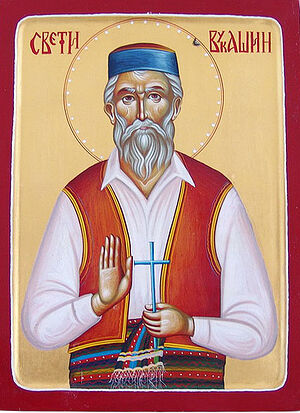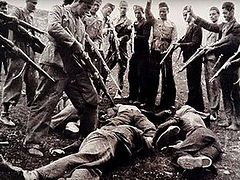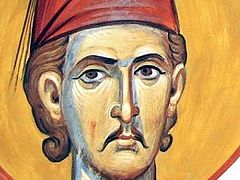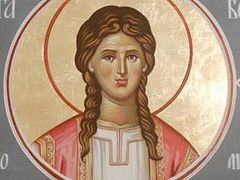The Lives
Jasenovac was a complex of concentration camps established by the Ustase (Croatian fascists) in August 1941. It was situated on the territory of the Independent State of Croatia (Nezavisna Drzava Hrvatska; the NDH), which collaborated with Nazi Germany, about forty miles from Zagreb.
Even the Nazis were horrified by the brutal treatment of its prisoners.
The New Martyrs of Jasenovac were Orthodox prisoners in Croatia who were martyred from 1941–1944. According to various testimonies, during the Second World War thousands of Orthodox Serbs were put to death at Jasenovac, many of whom died for their faithfulness to Orthodoxy. The Bishops’ Council of the Serbian Orthodox Church established the feast of the Synaxis of the New Martyrs of Jasenovac. The Russian Orthodox Church included their names in its calendar and established the commemoration of their feast on August 31 / September 13.
Martyr Vukasin of Klepci
 Photo: myocn.net Vukasin was an Orthodox Serb from the village of Klepci on the eastern bank of the Neretva River in Serbian Herzegovina. There used to be an early sixteenth-century Church in honor of the Apostle Luke in Klepci, which was founded and endowed by famous Serbian church builders from the noble Miloradovic family, and the Church of the Transfiguration of the Lord (which was destroyed together with the village by Croats in 1992).
Photo: myocn.net Vukasin was an Orthodox Serb from the village of Klepci on the eastern bank of the Neretva River in Serbian Herzegovina. There used to be an early sixteenth-century Church in honor of the Apostle Luke in Klepci, which was founded and endowed by famous Serbian church builders from the noble Miloradovic family, and the Church of the Transfiguration of the Lord (which was destroyed together with the village by Croats in 1992).
Elder Vukasin came from the Mandrap family. He was probably born in the late nineteenth century and grew up in his native village. When he came of age, he went to work in Sarajevo, the capital of Bosnia.
When the NDH was founded, Vukasin had to return to his native village. But the Croatian Ustase, Roman Catholics, got to those lands, too—the whole Vukasin family suffered from their terrible violence against Serbs, along with many other Orthodox Serbian families. And he together with other surviving Serbs was sent to the infamous concentration camp for Serbs called Jasenovac. In January 1943 Vukasin was brutally murdered by the Ustase cutthroat Zile Friganovic.
Noticing an old peasant who was observing the cutthroats’ atrocities with some incomprehensible wise calm, the butcher decided to crush this inexplicable peace. He took him aside, led him to the edge of a freshly dug pit into which mutilated half-dead people were thrown, and demanded that he shout: “Long live Ante Pavelic!” The old man was serene and silent. Then the brutal killer took a knife, cut off both his ears and nose and again demanded that he praise Pavelic, threatening to tear out Vukasin’s heart alive if he remained silent.
Looking at his tormentor peacefully, the blessed martyr said quietly but distinctly: “Do your job, child.” Such an answer, and the heavenly peace reflected on the holy martyr’s face, drove the butcher into a frenzy: beside himself with anger, he tore out his heart, put out his eyes and cut his throat… Until his last breath Vukasin kept the peace of Christ in his soul, and his last movement was the sign of the cross made with three fingers, for which the executioner cut off his hand; he himself, throwing the knife in a frenzy, who had already fallen into eternal perdition in his earthly life, kicked him into the pit with his feet.
Frescoes depicting the New Martyr Vukasin can be found at the Monastery of the holy Archangel Gabriel in Zemun, now part of Belgrade; at St. John’s Skete of Ostrog Monastery; his image is depicted among the most venerated saints of the Diocese of Zahumlje and Herzegovina on an icon painted to celebrate the diocese’s 780th anniversary.
The Executioner’s Testimony (recorded by Dr. Nedo Zec)
The Ustase who was telling me this story fell silent again; then, finishing a shot of rakia, he continued:
“Do you remember that in August we received a lot of new prisoners at the camp? Then Jere Maricic sent about 3000 inmates to be killed, and we—Pero Brzica, Zrinusic, Sipka and I—waged a bet on who would slaughter more inmates over the night. The murdering started, and after an hour I moved into the lead in terms of the number of people slaughtered. That night I was ecstatic: it seemed to me that I was in the seventh heaven—I had never felt such bliss before. Within a few hours I had slaughtered over 1000 people, while my rivals only managed to stab 300 to 400 each.
 Photo: myocn.net “And then, while I was experiencing the greatest ecstasy, my gaze fell on an elderly peasant, who was standing with some inexplicable calm and silently watching me kill victim after victim, and them dying in terrible agony. His gaze seemed to paralyze me: I froze and could not move for several seconds.
Photo: myocn.net “And then, while I was experiencing the greatest ecstasy, my gaze fell on an elderly peasant, who was standing with some inexplicable calm and silently watching me kill victim after victim, and them dying in terrible agony. His gaze seemed to paralyze me: I froze and could not move for several seconds.
“Then I pulled myself together and came up to him to find out who he was. He said that his name was Vukasin, that he came from the village of Klepci, that his whole family had been killed by the Ustase and he had been sent to Jasenovac. He spoke about it all with incomprehensible peace, which shook me much more than the terrible screams and moans of people dying around us. As I listened to the old man, looking into his heavenly, pure eyes, an indomitable desire suddenly appeared in me: to disrupt his inner peace so incomprehensible to me with the cruelest and most hellish tortures in order to regain my former ecstasy over spilled blood and pain through his suffering, groans and agony.
“I took him aside, sat him on a stump and ordered him to shout: ‘Long live Pavelic!’, threatening to cut off his ear if he disobeyed. Vukasin was silent.
“I ripped off his ear. He didn’t say a word. I again ordered him to shout, ‘Long live Pavelic!’ or I would rip off his other ear too. He was silent again. I tore off his other ear. ‘Shout: “Long live Pavelic!” or you’ll lose your nose!’ The old man was still silent. I ordered him to shout the same words for the fourth time, threatening to take out the living heart from his chest with a knife. He looked, as if through me, into infinity, and said softly yet clearly, ‘Child, do your job!’
“After those words I was beside myself with rage. Rushing at him, I gouged out his eyes, tore out his heart, cut his throat and threw him into the pit. And then something happened to me. I couldn’t kill anymore that night. Pero Brzica won the bet by slaughtering 1,350 inmates, and I silently paid him out.
“I’ve had no peace ever since. I took to drink, harder and harder, but alcohol only gives me oblivion for a short time, and even while drunk I can hear that voice saying, ‘Child, do your job!’ And then, bumping into the walls of houses, I run through the streets, with screams crushing and beating everything in my way, and throwing myself at anyone I meet. I cannot sleep at night: once I fall asleep I again see the old man’s serene look and hear that unbearable voice: ‘Child, do your job!’
“I have turned into a lump of horror and pain. I am powerless before this nightmare. Day and night the pure, serene face of Vukasin from Klepci keeps haunting me.”
The camp’s view of Serbian history
Nezavisna Drzava Hrvatska—fascism on Serbian soil
The future martyr happened to live in the NDH. It was a Nazi entity formed with the help of Hitler’s Germany and Mussolini’s Italy, and with the blessing of Pope Pius XII on the territory of Yugoslavia—Croatia and Bosnia and Herzegovina—immediately after the invasion of Yugoslavia by Hitler’s troops.
The NDH has gone down in history for its unprecedented atrocities committed by Croats against Serbs, Jews and Romani people. Over the course of the Second World War about two million Serbs were killed in the NDH. In the NDH the Serbs were outlawed—with the help of the Catholic Church, headed by Archbishop Aloysius Stepinac, whom Pope John Paul II later canonized, a monstrous, systematic policy of extermination of Serbs was carried out. It was permitted to kill and torture Serbs, expel them from their homes and seize their property with impunity…
Of the numerous concentration camps Jasenovac became the most notorious, in which 700,000 people died.
Vukasin from the old Mandrap family
 Photo: wikimedia.org Vukasin came from the Herzegovina Mandrap family, which had its own branch in Sarajevo (the capital of Bosnia), the ancient beautiful Mandrap mansion on Milos Obilic Street is well known.
Photo: wikimedia.org Vukasin came from the Herzegovina Mandrap family, which had its own branch in Sarajevo (the capital of Bosnia), the ancient beautiful Mandrap mansion on Milos Obilic Street is well known.
The Mandraps are an ancient wealthy merchant family of Sarajevo. They became famous as benefactors and defenders of Church property and the Church of Holy Archangels Michael and Gabriel, the so-called “old Serbian Orthodox church” of the fifteenth century, which was the oldest building in Sarajevo. The sons of the old Cic Mandrap—Cedo and Dobrilo, twenty and twenty–five years old respectively, had since April and May 1941 been associated with armed volunteer detachments defending the Serbian villages and places where Serbs were hiding from the Ustase terror and genocide, which had begun in May 1941 in the areas surrounding Sarajevo. Both of them were killed in Jasenovac, as was their uncle, St. Vukasin.
Only Mandrap’s son Bogdan, a severely disabled man, and daughter Slavka, a teacher, lived until the 1970s. In the 1980s her son, Cic Mandrap’s grandson, worked as a librarian at the Venica People’s (University) Library, which would later be filmed and shown in world media reports as “an object turned into ruins by Serbian grenades from Trebevic”, but in fact it was burned down in a fire. It was deliberately burned to destroy a huge denunciatory archive about Sarajevo’s past and about the coexistence of three religious communities (i.e., four, including the Jewish one) there.
The Mandrap mansion on Milos Obilic Street is a striking example of urban architecture of the eighteenth and the nineteenth centuries (it resembles Manak House in Belgrade, and even more the building in which the Question Mark restaurant is now located, opposite the cathedral in Belgrade), was supposed to become a monument of ethnic culture and be protected by the State.
The future holy martyr lived and worked as a salesman in this house. He was highly respected as a zealous defender of the Serbian Orthodox Church property in BasCarsija (a large well–known neighborhood of Sarajevo). This church and the whole Serbian Sarajevo have compelling reasons to praise St. Vukasin—a servant of God and of the Archangels—as their Heavenly protector and patron. Together with him Cedo, Dobrilo and other members of the Mandrap family served as singers and readers at the old church. And may the Lord grant that even today this church and Serbian Sarajevo be preserved by the icon and the faith of St. Vukasin of Jasenovac, Klepci, Herzegovina, Sarajevo, Serbia and all Orthodoxy!
Until his last breath he kept the peace of Christ in his soul, and his last movement was the sign of the cross made with three fingers, for which the cutthroat cut off his hand... May this sign of the cross of St. Vukasin of Jasenovac hover over this much-suffering nation as a blessing and peace, the peace of Christ; for only “with this sign shalt thou vanquish”!
From a chapter in the book, Glory and Pain of Serbia, Montenegro metropolia of the Serbian Orthodox Church





